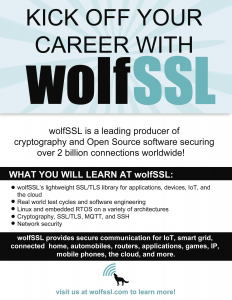Happy New Year! As we kick off 2023, wolfSSL is excited to announce a series of webinars to help you get started with our software.
First up is our webinar on January 5th at 10 AM (PST) on getting started with the wolfSSL TLS library. This webinar will cover a range of topics including an overview of TLS 1.3, how to build and use the wolfSSL library, and tips on debugging. There will also be a Q&A session to answer any questions you may have. Watch the webinar here: Getting Started with wolfSSL
On January 19th, join wolfSSL engineer Eric Blankenhorn for a webinar on our wolfMQTT library. This multi-platform, space-conscious and extensible library is a client implementation of MQTT written in C for embedded use, and supports SSL/TLS via the wolfSSL library. Bring your questions for the Q&A session to follow. Watch the webinar here: How to get Started with wolfMQTT
Finally, on January 26th, we’ll be hosting a webinar on getting started with wolfSSH, a lightweight SSHv2 client and server library. This webinar will cover topics such as the wolfSSH package structure, how to build and use the library, and debugging tips. As always, there will be a Q&A session to answer any questions you may have. Watch the webinar here: Getting Started with wolfSSH
If you have any questions or run into any issues, contact us at facts@wolfssl.com, or call us at +1 425 245 8247.




 Are you a college or university student interested in Internet security? Do you want to learn about cryptography and the implementation and application of Internet protocols (SSL/TLS, SSH, MQTT, TPM)? If so, apply for wolfSSL’s 2025 Summer of Security internship program!
Are you a college or university student interested in Internet security? Do you want to learn about cryptography and the implementation and application of Internet protocols (SSL/TLS, SSH, MQTT, TPM)? If so, apply for wolfSSL’s 2025 Summer of Security internship program!